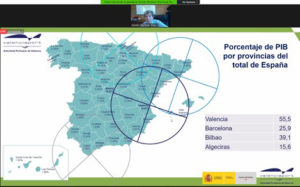
The President of the PAV points out that “Valenciaport’s leadership is thanks to the success of our export companies”
Aurelio Martinez explains at the Executive Forum Spain the strategic role of the Port of Valencia as a facilitator of commercial relations due to its connectivity, its commitment to digitalisation and its commitment to the environment
It has highlighted the value of the Madrid-Valencia axis in the import/export exchange for the dynamism of the Spanish economy
He points out that international trade will continue to grow, supported by maritime traffic which is the “most sustainable and efficient”
The President of the Port Authority of Valencia (PAV), Aurelio Martínez, has highlighted that “Valenciaport is acting as a platform for the export of our productive fabric, a key element in recovering the dynamism of the Spanish economy, as demonstrated in recent months by the increase in cargo containers (exports) in the Port of Valencia”.
The President of the PAV participated in the Executive Forum Spain where he highlighted to business representatives, public institutions and economic organisations the role of Valenciaport as a facilitator of Spanish commercial relations due to the volume of containers and movement of goods, connectivity, the commitment to digitalisation and the commitment to the environment.
During his presentation, Aurelio Martínez highlighted “the role of export companies, people who sell and buy to activate the economy, which are the key to the leadership of the port”. In this line, he explained that Valenciaport is the best placed port when it comes to providing services to 55% of the GDP of Spain and that its hinterland represents 60% of the import/export traffic of the Spanish economy.
“Valenciaport – explained Martinez – is an eminently commercial port which channels 50% of all the export/import maritime traffic of Madrid. We are a gateway for the entry and exit of goods with commercial relations with more than 70 countries, connected with 1,000 ports around the world and where the main shipping companies operate. We are the first port in Spain in container traffic and the fifth in Europe”.
Among the reasons for this leadership, the president of the PAV has appealed to “geographical, technical and, above all, human reasons”. Thus, for example, he highlighted the mixed nature of the Port of Valencia, which combines loading and unloading operations with transhipments, the connectivity with the rest of the countries and with its area of influence, or the commitment to digitalisation with tools such as ValenciaportPCS. He also pointed out that Valenciaport is a reference in sustainability due to its commitment to be a zero emissions port and energy self-sufficiency by 2030 with a defined plan that contemplates: feasibility studies for the installation of a wind farm; the implementation of photovoltaic solar energy; the replacement of the PAV vehicle fleet by hybrid and electric ones; the installation of an electric substation; the supply of electricity to ships in the port; or the use of clean fuels such as LNG or Hydrogen.
“All of this has led us to be the most intelligent port in the Spanish port system according to CEDEX, a position that makes us feel proud and reaffirms us to reinforce our leadership position as a reference hub in the Mediterranean for the management of goods and traffic, sustainability, digitalisation and transparency”, said Aurelio Martínez.
Remain competitive
The President of the PAV stressed that another of the keys to continuing to boost the Spanish economy is the infrastructure that connects Valencia with the rest of the country, which “allows us to continue to be competitive”. From there, he highlighted the “adequate connection with Madrid by rail and motorway, the need to continue to invest in the Mediterranean Corridor to improve rail connections with the rest of Europe and the Sagunto-Zaragoza line to strengthen the service between these two regions”.
He also pointed out the importance of the Port of Valencia’s new container terminal “to respond to the growing increase in maritime traffic and the needs of companies that use the port for the entry and exit of goods, as we are currently at 73% of our capacity”.
During his intervention in the Executive Forum, the President of the PAV highlighted the importance of the Madrid-Valencia axis in the economic activity of our country. Thus, according to a study by the IVIE and the Conexus Foundation, 33.1% of the sales of companies in the Valencia Region are made to the Region of Madrid, while purchases represent 35.6%. Furthermore, the railway corridor between Madrid and Valencia is the second in Spain in terms of both tonne-kilometres and thousands of tonnes transported, and 90% of the containers handled in the Dry Port of Madrid have their origin-destination in Valencia-Port.
Maritime transport, the most efficient
The President of the PAV also explained that “international trade will continue to grow and goods traffic will continue to be carried out by maritime transport, which is undoubtedly the most efficient and sustainable. For this reason, we must continue to strengthen Valenciaport as a strategic hub for the export of our products and continue to channel our country’s commercial activity with the rest of the world”.
The fact is that maritime traffic is the fundamental means of connecting the world’s commercial traffic flows (90% in volume and 73% in value). For the President of the PAV, “the studies show that transport by sea is the most efficient and ecological. Thus, while the ship generates three grams of CO2 for every ton of goods per kilometre, the railway is six times more, road transport 15 times more and air transport 200 times more”. In addition, containerised freight traffic is the most competitive in terms of cost per tonne.

